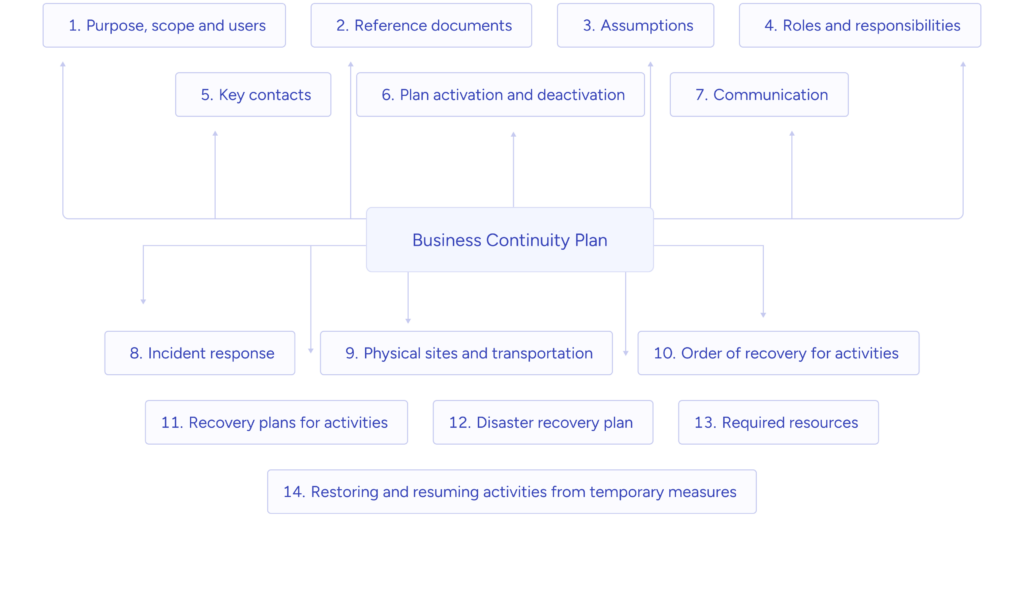Business Continuity (BC) constitutes a comprehensive managerial process that serves as a safeguard to ensure an organization’s capacity to sustain its crucial operations and deliver indispensable services, even in the face of an array of disruptive forces. These potential disruptions encompass a spectrum of challenges, ranging from natural disasters, technological glitches, and cyberattacks to unforeseen and abrupt events.
At its core, a Business Continuity Plan (BCP) aims to ensure the seamless operation of essential functions in challenging circumstances, safeguarding critical services and workflows. It mitigates disruptions, reducing downtime and losses while protecting stakeholders like employees, clients, and suppliers. Regulatory compliance is key to avoiding legal issues.
Moreover, BCPs enhance an organization’s reputation, demonstrating reliability and building trust. They also promote financial stability by minimizing losses and maintaining revenue in the face of disasters.

Common Business Risks and Vulnerabilities
Businesses encounter a diverse range of hazards and vulnerabilities that can disrupt their operations and jeopardize their sustainability.
- Natural Calamities
- Technological Hiccups
- Supply Chain Interruptions
- Human Variables
- Regulatory Transformations
- Economic Variables
Common risks include natural disasters like earthquakes, floods, and wildfires, which damage infrastructure. Technological issues such as hardware failures and cyber threats can disrupt digital operations. Overreliance on suppliers can affect production, while human errors or malicious actions may cause disruptions, especially if key personnel are unavailable. Regulatory changes impact operations, and economic factors like downturns and market volatility can affect financial stability
Without a robust BCP, businesses risk prolonged downtime, financial losses, and customer dissatisfaction, potentially leading to closure. This can also harm their reputation, result in revenue decline, and lead to regulatory penalties. Inadequate crisis management can erode trust, jeopardize employee safety, and hinder competitiveness.
Business Continuity Preparation Checklist
| Step/Consideration | Description/Notes |
|---|---|
| Risk Assessment | Identify and assess potential risks and threats to the business. This includes natural disasters, cybersecurity threats, supply chain disruptions, etc. |
| Business Impact Analysis (BIA) | Conduct a BIA to determine the criticality of various business functions, their dependencies, and the impact of downtime. |
| BCP Team Formation | Establish a dedicated team responsible for developing, implementing, and maintaining the Business Continuity Plan (BCP). |
| Set Objectives and Priorities | Define clear objectives for the BCP, prioritize critical functions, and allocate resources accordingly. |
| Communication Plan | Develop a comprehensive communication plan for both internal and external stakeholders during emergencies. |
| BCP Documentation | Create detailed BCP documentation, including policies, procedures, and recovery plans for each critical function. |
| Resource Allocation | Allocate the necessary resources, including personnel, technology, and financial resources, to support BCP implementation. |
| Training and Awareness | Provide training and awareness programs to ensure employees understand their roles and responsibilities in the BCP. |
| Technology and Data Protection | Implement technology solutions for data backup, redundancy, and cybersecurity to safeguard critical systems and data. |
| Supplier and Partner Engagement | Engage with suppliers and partners to ensure they have their own BCPs in place and align with your continuity efforts. |
| Testing and Exercises | Regularly test the BCP through tabletop exercises, functional drills, and full-scale simulations. |
| Continuous Improvement | Establish a process for collecting feedback, learning from incidents, and updating the BCP to enhance its effectiveness. |
| Regulatory Compliance | Ensure the BCP complies with relevant regulations and industry standards. |
| Alternative Facilities and Remote Work | Identify backup facilities and establish remote work capabilities to maintain operations during facility disruptions. |
| Crisis Communication Tools and Channels | Implement tools and communication channels (e.g., emergency notification systems) for rapid dissemination of information during crises. |
| Recovery Time Objectives (RTOs) | Define specific RTOs for each critical function, indicating the acceptable downtime for recovery. |
| Legal and Compliance Considerations | Consider legal and compliance aspects, including contractual obligations, insurance coverage, and data protection regulations. |
| Vendor and Service Provider Assessment | Evaluate the resilience of vendors and service providers to ensure they can support your BCP. |
| Incident Response Plan | Develop a detailed incident response plan to guide immediate actions during emergencies. |
| Employee Safety and Well-being | Establish measures for ensuring employee safety and providing support during crises. |
| Financial Preparedness | Maintain financial reserves or insurance coverage to cover costs associated with BCP implementation and recovery efforts. |
| Record-Keeping and Documentation | Maintain records of BCP activities, tests, and incidents for auditing and reporting purposes. |
| Periodic Reviews and Updates | Schedule regular reviews of the BCP to assess its relevance and update it as needed based on changing risks and circumstances. |
Preparing for Business Continuity
Risk Assessment
Conducting a comprehensive risk assessment is a fundamental step in preparing for business continuity, forming the foundation of the Business Continuity Plan (BCP). The process of conducting a risk assessment involves several essential steps.
Organizations identify potential risks through various means, including historical data review, employee interviews, and industry trend analysis. Common risk categories include natural disasters, technological failures, human errors, and external threats such as cyberattacks.
Risks are categorized based on their severity and potential to disrupt operations. Priority is given to critical risks that could significantly impact the business. Comprehensive risk assessment process is vital in enhancing an organization’s readiness and resilience in the face of potential disruptions.
Business Impact Analysis (BIA)
A Business Impact Analysis (BIA) is a crucial component of the BCP as it focuses on understanding the specific impact of disruptions on the organization. Its role includes:
Prioritizing Critical Functions
A BIA identifies and prioritizes critical business functions and processes, helping organizations determine which areas require the most attention during recovery efforts.
Determining Recovery Time Objectives (RTOs)
By analyzing the BIA results, organizations can establish RTOs, which specify the maximum allowable downtime for critical functions.
Resource Allocation
The BIA informs resource allocation decisions, ensuring that resources are directed towards recovering the most vital aspects of the business.
Risk Reduction
It helps organizations understand how different risks may affect their operations and allows them to proactively mitigate these risks.
? Ready to safeguard your data and ensure business continuity? Don’t wait for a disaster to strike. Take proactive steps now with our Backup and Disaster Recovery Service!
BCP Team
Establishing a BCP team is essential for effective preparedness. Key roles and responsibilities include:
BCP Coordinator: Oversees the entire BCP process, ensures alignment with organizational goals, and coordinates all BCP activities.
Team Leaders: Appointed to lead specific recovery teams or departments, responsible for implementing recovery strategies.
Communication Coordinator: Manages internal and external communication during emergencies and ensures timely updates to stakeholders.
Resource Coordinator: Manages resource allocation, procurement, and logistics required for recovery efforts.
IT Specialist: Focuses on IT recovery strategies, including data backup, system restoration, and cybersecurity.
Safety and Security Officer: Ensures the safety and security of employees, facilities, and assets during disruptions.
HR Liaison: Addresses personnel-related issues, including employee well-being, workforce mobilization, and HR policies during recovery.
Legal and Regulatory Compliance
Various industries and jurisdictions have specific regulations related to business continuity planning. Common examples include:
Financial Industry. Regulations like Basel III require financial institutions to have robust BCPs in place to ensure financial stability.
Healthcare. The Health Insurance Portability and Accountability Act (HIPAA) mandates that healthcare organizations have contingency plans for protecting patient data and ensuring continued patient care during emergencies.
Energy Sector. Regulations in the energy sector often require utilities to have BCPs to maintain critical infrastructure and services.
Developing the Business Continuity Plan
Business Continuity Strategies
Business Continuity Strategies encompass a range of proactive measures and plans aimed at sustaining critical operations during disruptions. These strategies may involve establishing backup facilities, leveraging cloud solutions, and making risk-informed selections to ensure an organization’s resilience in the face of adversity.
Emergency Response
Emergency Response involves the development and implementation of procedures and protocols to address immediate crises and disruptions effectively. It emphasizes rapid and coordinated actions, with a primary focus on safeguarding people, assets, and critical operations. Effective communication and swift decision-making are vital components of a robust emergency response plan.
Data Backup and Recovery
Data Backup and Recovery entail the establishment of systematic processes for safeguarding and restoring critical data and information. This includes routine backups of essential data, the creation of redundancy measures, and the provision of clear procedures for data retrieval in the event of data loss or system failures. The aim is to minimize data-related disruptions and ensure the continuity of essential business functions.
Data backup and recovery procedures involve:
- Regular automated backups of critical data.
- Testing the integrity of backups to ensure data recoverability.
- Detailed recovery plans specifying who is responsible for data restoration.
- Off-site backup storage to safeguard data in case of on-site disasters.
Testing and Maintenance
Regular testing of the BCP is essential to ensure its effectiveness. It allows organizations to assess their preparedness, identify weaknesses, and refine response procedures. Various testing methods, such as tabletop exercises and drills, are employed to simulate different scenarios and evaluate the plan’s robustness.

To comprehensively evaluate our BCP, we employ a range of testing methods, including:
Tabletop Exercises: These scenario-based discussions involve key stakeholders to simulate crisis situations, fostering collaboration, and identifying areas for improvement.
Functional Drills: Practical exercises replicate real-world scenarios, enabling employees to execute specific BCP tasks and assess their effectiveness.
Full-Scale Simulations: These elaborate tests mimic large-scale disasters, testing the entire BCP and its ability to handle complex situations.
IT Recovery Testing: Ensures the functionality of our IT systems and data recovery procedures, including failover tests for critical applications.
Continuous improvement is a key aspect of BCP management. It involves gathering feedback from testing and real-world incidents, learning from experiences, and applying those lessons to enhance the BCP. This iterative process ensures that the plan remains relevant and resilient to evolving challenges.
To ensure our BCP remains robust and adaptable, we follow a structured process for updating and improvement:
Post-Testing Evaluation: After each test or real incident, we conduct a thorough review to capture feedback and lessons learned.
Analysis and Prioritization: We analyze the feedback and prioritize areas that require attention based on their impact and criticality.
Revision and Enhancement: The BCP is revised to address identified weaknesses, incorporating improvements and updates.
Communication: Revised BCP versions are communicated to all relevant stakeholders, and training and awareness programs are conducted as needed.
Regular Review: We establish a schedule for periodic BCP reviews, ensuring that it remains aligned with our business goals and current risk landscape.
Conclusion
To facilitate the execution of an effective Business Continuity Plan tailored to your organization’s unique needs, consider Gart’s Backup and Disaster Recovery Services. These services provide comprehensive support and resources for crafting a resilient BCP that aligns seamlessly with your operational landscape. Gart’s expertise ensures that your BCP is robust, adaptable, and in compliance with relevant regulations, all while safeguarding your reputation and financial stability. With Gart’s Backup and Disaster Recovery Services, your organization can confidently navigate disruptions and emerge stronger on the other side.









